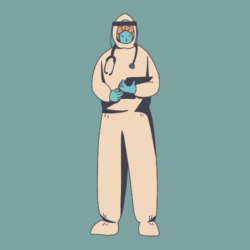During one of our first meetings with Christine Caruso, Chief Research and Advocacy Officer at Hispanic Health Council, we discussed the importance of placing youth at the forefront of our research. Youth Participatory Action Research became the lens under which we wanted to conduct our focus groups, interviews, and all other findings that fell into our research topic. While we had initial goals, they ultimately could not be achieved.
When reaching out to a youth group in Hartford, a community leader brought to our attention that it was difficult for youth to talk about their experiences during the pandemic due to any possible resulting trauma. It was something we hadn’t considered, and it contextualized why we were having such a difficult time finding youth participants.
Health Inequities
Our research focused heavily on reasons for the mistrust of the medical system and to understand this it is important to understand the history of health inequities that have caused a deep mistrust of the system for many marginalized communities. Many of the healthcare systems in place today were built to benefit those in power and this leads to a deep-rooted mistrust of the medical system by those who have been denied access or been hurt by the system in place. When going into our research we did realize it was very important to keep an open mind and be more understanding of the stories we hear with this knowledge in mind. It was important that we had a deeper background onto the social inequities that have allowed for disproportionate rates of vaccination and an overall lack of trust.
Many researchers and public health workers use the social determinants of health to better understand people’s situation and health status. The social determinants of health are the social and environmental factors that determine someone’s health outcomes and quality of life.(1) While there are many that can contribute to someone’ health, the most common determinants are defined as Education Access, Healthcare, Neighborhood and Environment, Social and community context, and economic stability.(2) All these factors play an important role in determining someone’s health and they are also very important when attempting to understand why people might refuse a Vaccine or why there is disproportionality low rates in certain areas, with for example less economic stability or little access to quality Healthcare.
COVID-19 impacted everyone, but it truly exposed the vast health inequities in America. Even at the very beginning of the pandemic, there were disproportionality higher rates of infection and more serious complications among Black, Latino and Indigenous communities. (3) Access to necessary protection, such as masks and later vaccines, was found to be distributed at a higher rate to wealthy, white communities, (4) and true infection rates were often miscalculated in many marginalized communities. While it may seem many of the health inequities came about during this pandemic, all COVID-19 did was expose these already vast health inequities in America and more specifically Connecticut.
While Connecticut does have a better standard of living and better healthcare than most of America, these numbers often only take into account living standards for those who live in wealthy, suburban areas. In fact, those who live in Urban areas in Connecticut have a significantly lower rate than that of the rest of the United States. (5)
